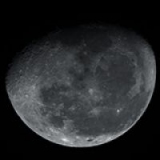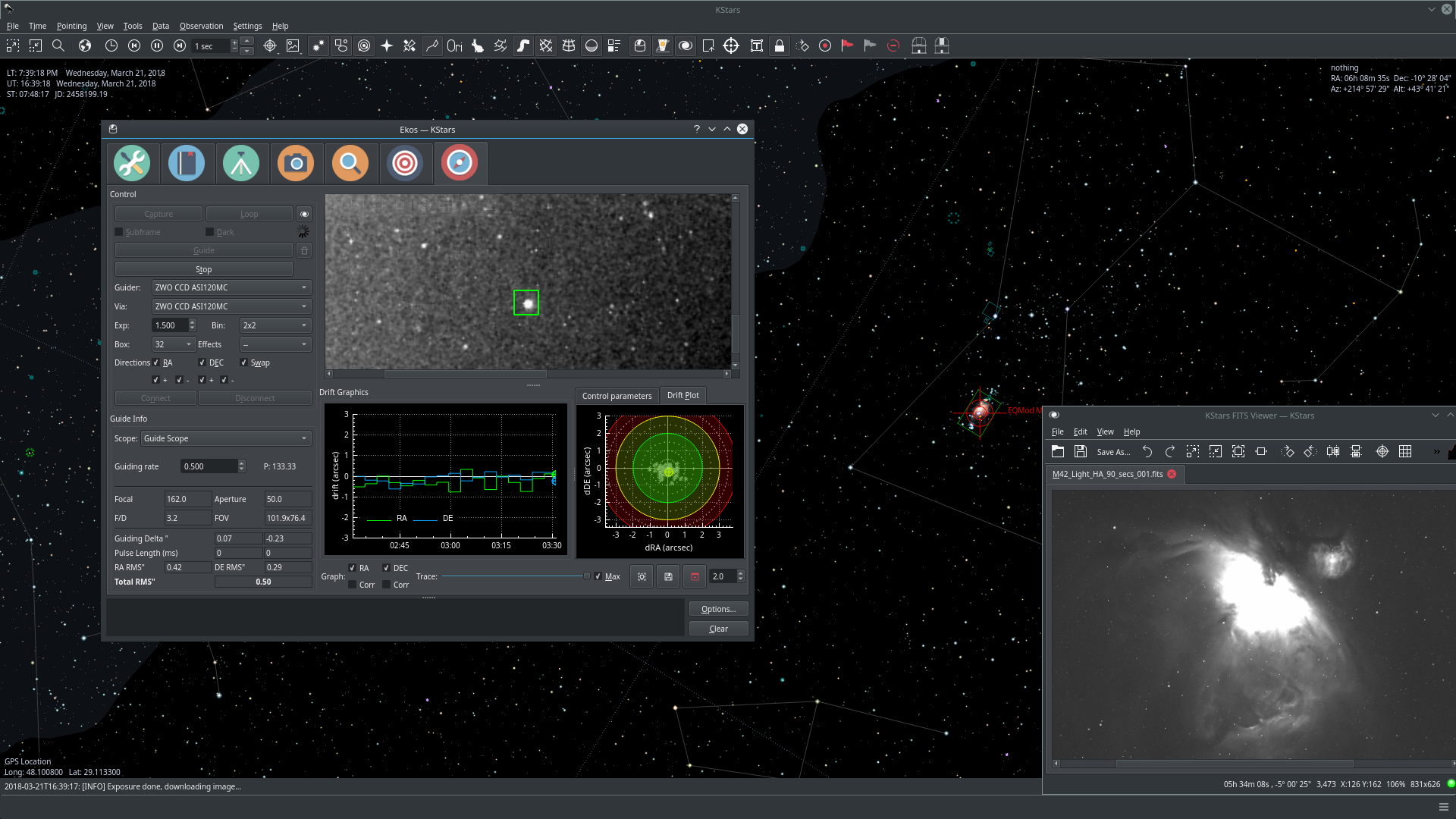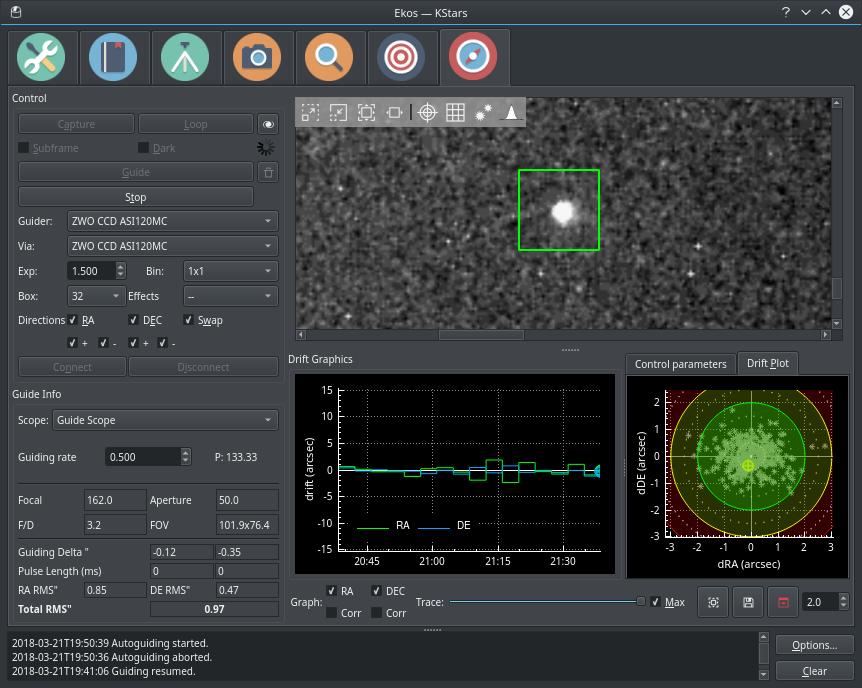INDI Library v2.0.7 is Released (01 Apr 2024)
Bi-monthly release with minor bug fixes and improvements
First night out with KSTARS/EKOS
- Rob Lancaster
-

- Offline
- Supernova Explorer
-

- Posts: 2877
- Thank you received: 811
Replied by Rob Lancaster on topic First night out with KSTARS/EKOS
This method has a large number of advantages over running everything on the computer at the telescope and just using VNC. It is for these advantages that I and several other people worked for a year to port KStars to Mac. By doing it this way you can put an inexpensive computer like a raspberry pi at the telescope so you don't care if it gets damaged and in fact mine is attached to the side of the telescope. The wires are also shorter running between the devices and computer because they never have to come off the scope. Your more powerful (and expensive) computer can be inside the house running KStars, not on the remote computer. This will also distribute the load between computers. The more powerful computer can be doing plate solves, downloading files, running the planetarium software, and managing sequences. The less powerful computer at the scope just has to handle the INDIServer and guiding.
But to be honest, those aren't the main reason I did it. The main reason I abandoned the VNC approach and spent all that time porting KStars to Mac is because VNC can be quite laggy. It is a lot more pleasant to be controlling a piece of software on the computer you are currently sitting at, rather than trying to control it over a VNC connection. With the approach I am outlining, the only thing you need to use VNC to do on the remote computer (at least with my setup) is to change some settings in PHD2 and to shut down the remote computer.
I have not completely abandoned the approach you described, however, since it also has advantages sometimes. I keep that as an option for when I go to star parties. So then I can have the raspberry pi run the whole show and I can put my laptop to sleep and just use VNC to check on the system every now and then. This will save significant power since my laptop draws about 2.4 amps at 12 volts. The other way this could be used would be to have more than one scope setup, each with a raspberry Pi strapped to it, and have them set up to run using the scheduler. So this way you could have a robotic telescope basically.
Please Log in or Create an account to join the conversation.
- Andrew Burwell
-
 Topic Author
Topic Author
- Offline
- Platinum Member
-

- Posts: 527
- Thank you received: 139
Replied by Andrew Burwell on topic First night out with KSTARS/EKOS
I had read, and understood that this is the way INDI worked, and have connected from a desktop client install to the version on my laptop out by the telescope. But it was just a second full EKOS/Kstars install. And I just realized by reading your post I could have just put the server. In fact, I would love to support Stellarmate and have a PI version running at the scope, but didn't make the effort to explore it since there have been so many bandwidth issues reported with other software (not specifically INDI) in running the two cameras I have, which are both USB3 and tend to eat up lots of bandwidth.
I don't have any issues with power since I've got electricity out to my scope, but do like the aspect of running an inexpensive PI unit on each scope since I have three currently. I do experience some issues with lag but in general it's not been a huge issue. I think Apple's screen sharing approach might be a little more robust than VNC. Since I'm still connected wirelessly, I wonder what it's like transferring 32mb images across every minute. Seems like it should be able to do that without much issue if I'm imaging 60s or longer per image. It should be enough time for it to get over the wire without any issue.
Please Log in or Create an account to join the conversation.
- Rob Lancaster
-

- Offline
- Supernova Explorer
-

- Posts: 2877
- Thank you received: 811
Replied by Rob Lancaster on topic First night out with KSTARS/EKOS
github.com/rlancaste/AstroPi3
Then you can see what you like better. I specifically made that to support both major use cases. As I said, sometimes at star parties, I think it might be nice to turn off the laptop and let the pi do everything, but at home I definitely prefer running KStars on my laptop. I like to keep my options open.
Please Log in or Create an account to join the conversation.
- Jasem Mutlaq
-

- Away
- Administrator
-

Replied by Jasem Mutlaq on topic First night out with KSTARS/EKOS
I'm not sure what "Auto Routine" you're talking about exactly here? For your mount, you need to perform the 2-3 stars alignment using the hand-controller before connecting to Ekos.
How did you set park position? To set parking position, just right-click anywhere on the sky map, but not TOO close to Polaris, and then from the menu go to Celstron and then -> Set As Parking Position. Next time you park, it should go there.
Yes! This is the correct procedure.
I've had several issues with getting my ZWO ASI120 to guide correctly as well. Were you able to select "LUMA" in the ASI driver? You probably don't want to guide on color frames due to increased noise. Ideally, you don't need to use filter. I will try today to test my ZWO camera again and check what settings were used to make it guide properly and I'll report back.
Absolutely! I'll try to check these issues today with my observatory. I usually use my faithful Lodestar X2 for guiding, but I'll mount the ZWO ASI today as well and see how it goes. Thank you for your patience!
Please Log in or Create an account to join the conversation.
Replied by Greg on topic First night out with KSTARS/EKOS
I've got the ASI120mm and haven't had any issues with it after updating its firmware when I started using Stellarmate. The thing that just occurred to me and that I find strange is I see weird colours too even though its a monochrome camera! So something not right there :-S
Please Log in or Create an account to join the conversation.
- Rob Lancaster
-

- Offline
- Supernova Explorer
-

- Posts: 2877
- Thank you received: 811
Replied by Rob Lancaster on topic First night out with KSTARS/EKOS
Please Log in or Create an account to join the conversation.
- Andrew Burwell
-
 Topic Author
Topic Author
- Offline
- Platinum Member
-

- Posts: 527
- Thank you received: 139
Replied by Andrew Burwell on topic First night out with KSTARS/EKOS
The auto routine I was using was the Mount Model settings under the align tab. I added three stars that were visible, hoping it would slew to them automatically and solve each one, then sync. But I think it didn't because of the issue you addressed above that with my mount I have to perform a hand control 2-3 star align before I connect EKOS.
For setting the park position I moved the mount to it's home position, which is just to the side of Polaris, went in to the INDI driver control panel for my mount, and under the park options selected use current, then write data. I have not tried what you suggested, but will attempt it the next night out.
As for the guiding camera. I believe I tried LUMA, I think I pretty much tried all the options with no luck. I got out for a second night last night, and used PHD2 from the beginning with very little issue. But I need to make another attempt with EKOS for guiding.
Please Log in or Create an account to join the conversation.
- Andrew Burwell
-
 Topic Author
Topic Author
- Offline
- Platinum Member
-

- Posts: 527
- Thank you received: 139
Replied by Andrew Burwell on topic First night out with KSTARS/EKOS
I haven't attempted it again, but maybe I'll hook it up and make a screen recording, so it can be seen what is happening.
Please Log in or Create an account to join the conversation.
Replied by Greg on topic First night out with KSTARS/EKOS
Please Log in or Create an account to join the conversation.
- Rob Lancaster
-

- Offline
- Supernova Explorer
-

- Posts: 2877
- Thank you received: 811
Replied by Rob Lancaster on topic First night out with KSTARS/EKOS
Please Log in or Create an account to join the conversation.
- Jasem Mutlaq
-

- Away
- Administrator
-

Replied by Jasem Mutlaq on topic First night out with KSTARS/EKOS
When I captured first, I also got the pink-color, and then I went to ZWO control panel and changed it to Luma
Then it worked fine. I spent a bit of time to get it focused and used looping for that, but once focused, I set it binning to 2x2 and then started guiding and it worked flawlessly afterwards with absolutely no changes.
Please Log in or Create an account to join the conversation.
- Jasem Mutlaq
-

- Away
- Administrator
-

Replied by Jasem Mutlaq on topic First night out with KSTARS/EKOS
Please Log in or Create an account to join the conversation.



